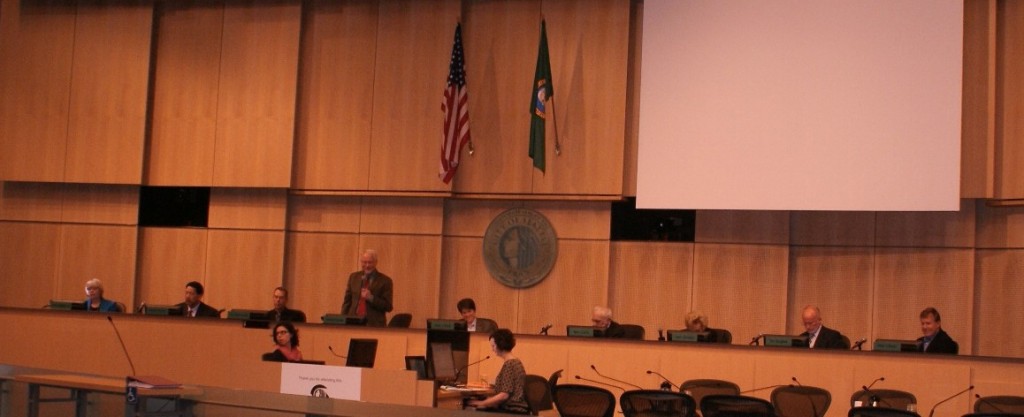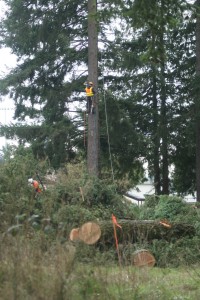The following comments were submitted by Save the Trees – Seattle to the Seattle Urban Forestry Commission regarding the Seattle Department of Planning and Development’s latest draft Tree Ordinace. You can see the draft proposal here: www.seattle.gov/dpd/Planning/trees
Preliminary Comments to the Seattle Urban Forestry Commission –
regarding latest DPD draft of tree ordinance
July 18, 2012
Save the Trees-Seattle
Our initial observations: This draft is a disappointment but not unexpected considering DPD’s previous proposal. DPD spends the bulk of the 56 page draft ordinance on specific provisions regarding sites where they are issuing building permits and very little on protecting trees outside the development process.
While there are some good additions, like requiring all projects to add street trees, this provision already exists in most zones. They are adding it for Single Family Residential and Institutions. And while it appears they are now requiring permits to remove exceptional trees which they define as over 24″ in diameter, at the same time they remove any limitations on removing any trees smaller than this and also remove protections for tree groves. Brennan Staley made the comment at the UFC that one analysis showed that only 14% of the trees in the city were over 24″ dbh, meaning that 86% of the trees could be removed outside the development process with no limitations.
Their old definition for removing trees was that they would be saved unless they limit the development potential of a lot. They are now saying an exceptional tree will be saved “unless the location of proposed principle (sic) structure would not allow an adequate tree protection area…” It’s just a different way of saying the sane thing.
By simplifying their definition of an exceptional tree to one 24″ in diameter they are removing protections for many trees that the Director’s Rule 16-2008 on Designation of Exceptional Trees classified as exceptional with a much smaller dbh depending on the tree species. Madrona trees for example were classified as exceptional at 6″ dbh and Quacking aspen at 12″ and Pacific dogwood at 6″. They would no longer be exceptional under DPD’s new proposal.
Currently people are able to remove 3 trees a year from their property. This is way too many but DPD removes all protections for trees less than 24″ in diameter . The current system is not acceptable because the number needs to be less and because we need a permit system to track loss and hopefully slow loss by educating people on the value of our trees. Vancouver, BC, eg, limits removal to 1 per year. Shoreline’s recently passed ordinance varies the number based on lot size.
DPD does nothing to mitigate loss of non-exceptional trees. The problem remains that tree protection should not be under DPD. It should be administered by a department that has a vested interest in saving trees and can be an advocate for doing that, not a Department whose main mission is to help people develop their property and find ways to make it easier for them to remove trees. Possible Departments with more of a mission to save trees include Seattle Public Utilities, Office of Sustainability and Environment and the Parks Department. DPD could still oversee the process of tree protection during development but not over private trees outside development.
Some good things in the draft:
1. Adding single family homes and institutions undergoing development to list of zones that must add street trees.
2. Requiring an online permit to remove trees larger than 24″ dbh.
3. Implementing tree removal application fee for exceptional trees to help cover cost and evaluation
4. Removing single family home lots smaller than 5000 sf from not being covered by new ordinance.
5. Higher credit given for evergreens saved or planted during development
What is missing from this draft:
1. Protection of tree groves
2. Protection of trees smaller than 24″ dbh, including trees previously classified as exceptional
3. A permit system for trees smaller than 24″dbh
4. Extending the permit system for exceptional trees to include public trees
5. Consolidating oversight, regulation and enforcement in a Department without a conflict of interest like DPD has.
6. licensing and training for arborists and tree removal companies
7. posting completed tree removal applications on line and posting of property
8. requiring disclosure of exceptional trees on property by real estate agents when property is sold
9. incentives to save trees like utility rebates
10. replacement of trees removed so there is no net loss of canopy over time, except some during development for not meeting credits
11 requirement to id all trees on property in development plans.
12. more emphasis on native trees and habitat values in tree plantings and preservation
It is important to note that Portland has approved a much more far reaching ordinance last year to protect their trees citywide that goes into effect in 2013.
At the last Urban Forestry Commission meeting Brennon Staley, the DPD lead for the new draft tree ordinance, asserted that if his version is enacted we would have the strongest tree ordinance of any large NW city. I do not agree.
I forwarded this post last September to the UFC noting that Portland has made significant moves in their urban forestry protection efforts, including protections for private trees on single family lots.
http://www.majorityrules.org/2011/09/portland-oregon-leads-the-way-in-protecting-its-trees-seattle-needs-to-follow.html
Here are the two pertinent links in that post, You’ll have to log in to the city website to access them. Because the bulk of the new tree ordinance does not go into effect until next year (2013) it appears the new ordinance does not come up easily in a Google search of Portland’s tree policies. This may be the result of an effort by Portland to not confuse the public as to what they are currently required to do.
http://www.portlandoregon.gov/bps/index.cfm?&a=345713 2 page summary
https://www.portlandoregon.gov/bps/article/350786?&login=1 Title 11 Trees Portland, Oregon
I will be providing more detail on Portland’s law in my public comments later but wanted to give UFC members a chance to check out the links before today’s meeting. We can do a lot more to protect private trees than DPD’s current draft proposes.
Steve Zemke
Chair – Save the Trees -Seattle
stevezemke@msn.com




